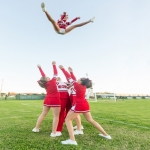
Cheerleading didn’t use to be a sport but we can’t say that anymore. It all started when a few students started standing up in the stands and cheered their team on. It has now morphed into a display of aerobatics, gymnastics, stunting along with chanting and yelling all rolled into one very large package of pompoms and rah- rah’s. It is now an intense, disciplined, and yes -risky sport.
It is more than showing up to the football game on Friday night in your uniform. It is a year round sport; from tryouts starting in the summer and going until spring. A cheerleader must demonstrate their strength, flexibility, and energy.
Cheerleaders have to prepare for jaw dropping stunts and flips. They have to work on strength to be able to perform stunts but remain flexible at the same time. Endurance is also very important. When you fatigue, that’s when injuries happen.
Some cheerleading squads are competitive and others are recreational in that they only perform at games. No matter where the fun is being held there is always a risk for an injury.
“The U.S. Consumer Product Safety Commission (CPSC) estimates that cheerleading let to 16,000 emergency room visits in 2002.”

Especially in cheer leading there are so many different aspects that it isn’t one area where all the injuries are coming from. A cheerleader could injure themselves doing gymnastics if not properly warmed up.
Several members of the quad could get hurt during the ever famous pyramid if one person isn’t focused or if they are experimenting with a new trick.
There are different roles when it comes to forming the pyramid. Sure, it looks easy and cool but it can take weeks of practice to make it perfect.
“While not as frequent as injuries in other sports, cheerleading injuries tend to be more severe, making up more than half of the catastrophic injuries in female athletes.”
Positions of a cheerleader:
There is a flyer, the girl who is held up in the air and will do tricks. The other cheerleaders are holding her up by her feet are called the bases. The cheerleader catching her from behind is called the back spot. There is, on occasion, a girl helping out in the front called a front spot.
Each role in a pyramid is just as important as the next. It’s risky- if everyone isn’t in their right mind set or peak physical condition it sets them all up for failure and potential injury.
With coordination and team work, the squad is able to pull off eye catching stunts.
Men in the sport:

Cheerleading is no longer just for girls anymore either. Male cheerleaders are called yell leaders. They are becoming more popular. While yell leaders can use their strength to help the stunts become solid, there is still a chance for injury. Practice makes perfect.
After seeing serious injuries in the sport, we now have restrictions that have been placed on stunts to help lower the catastrophic injuries. There are also regulations on what stunts may be performed on either grass or mats to help prevent serious injuries. They have begun to regulate what kind of stunts and tricks may be performed. Some have been deemed illegal and no longer used due to previous injuries.
Despite all the training and practice; injuries happen. All the training is to protect everyone involved from catastrophic injuries. When you get that occasional wrist or ankle sprain, don’t forget to R.I.C.E.
By: Taylor Ubben
Source:
http://www.stopsportsinjuries.org/STOP/STOP/Prevent_Injuries/Cheerleading_Injury_Prevention.aspx

